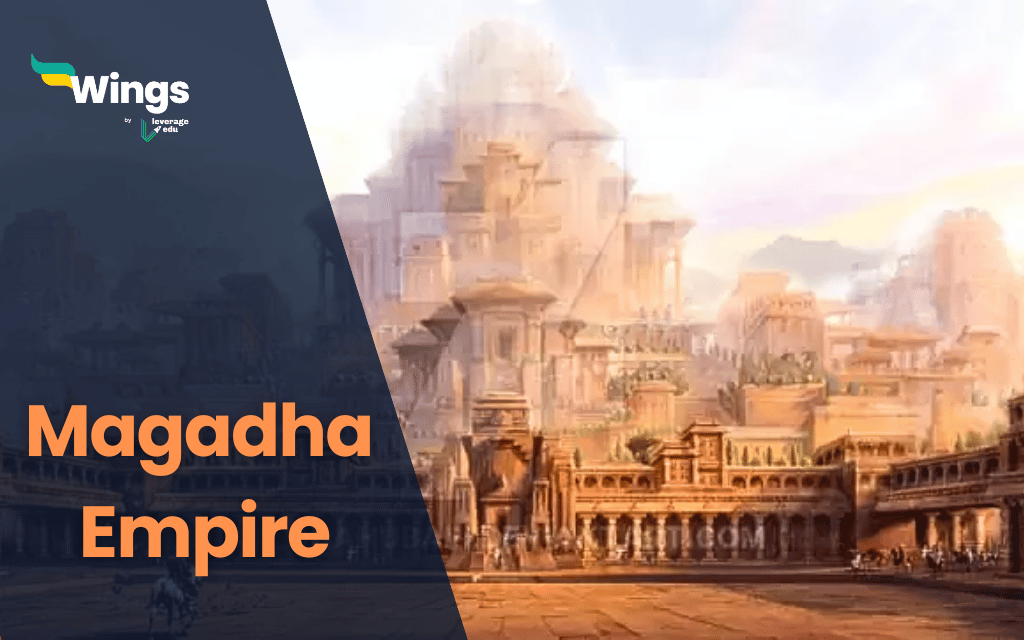The kingdom of Magadha was where we have west-central Bihar today. However, between the 6th and 8th centuries, this kingdom was the epicentre of major influence over other kingdoms and empires. Magadha Empire was situated over the river Ganges (Ganga) which gave it a strategic position for communication as well as trade by providing access to rich ports.
Contents
Rise of the Magadha Empire
In ancient India, four powerful Mahajanapadas, Magadha, Kosala, Avanti, and Vatsa, were engaged in a prolonged struggle for dominance. Among them, Magadha eventually emerged victorious, marking the beginning of its rise as a dominant imperial power. This victory laid the foundation for political unity and a centralised rule in northern India.
The early foundation of the Magadha Empire is attributed to the legendary figures Jarasandha and Brihadratha, both of whom are also mentioned in the epic Mahabharata. While their rule marked the beginning, the real expansion and consolidation of the empire began under the Haryanka dynasty.
The growth and strength of Magadha were then furthered by the Shishunaga and Nanda dynasties. However, it was under the Mauryan dynasty that the empire reached the peak of its power, wealth, and territorial expansion, becoming one of the most influential empires in Indian history.

Reasons for the Rise of Magadha
| Factor of Rising | Explanation |
| Strategic Location | The availability of iron in Chotanagpur helped in making weapons and tools |
| Fertile Land | Supported good agricultural production and food security |
| Iron Resources | Availability of iron in Chotanagpur helped in making weapons and tools |
| Located near the Ganga River, enabling trade and agriculture | A well-organised and large army gave it an advantage over rival kingdoms |
| Ambitious Rulers | Kings like Bimbisara and Ajatashatru focused on expansion and diplomacy |
Magadha expanded by defeating rival kingdoms like Kosala and Lichchhavi, setting the foundation for future empires.
Also Read: Maratha Empire (1674-1818): History, Wars, Important Leaders
Dynasties that Ruled the Kingdom of Magadha
Several powerful dynasties ruled Magadha over time. Each dynasty played a major role in its development and expansion.
Haryanka
The Haryanka Dynasty was the first ruling family of Magadha, founded by King Bimbisara in the 6th century BCE. This dynasty laid the foundation of Magadha’s political strength.
Important Rulers of the Haryanka Dynasty
| Ruler | Contributions |
| Bimbisara | Strengthened Magadha through marriage alliances and the conquest of Anga |
| Ajatashatru | Expanded the kingdom by defeating the Lichchhavis and using war technology like catapults |
| Udayin | Established the city of Pataliputra as the new capital |
The Haryanka rulers were also known for their patronage of Jainism and Buddhism.

Shishunaga Dynasty
The Shishunaga Dynasty came after the fall of the Haryankas. Shishunaga, the founder, initially served as a minister before becoming king.
Key Features of the Dynasty
- The Shishunaga Dynasty temporarily moved the capital of Magadha to Vaishali, likely for administrative convenience or political strategy.
- The rulers of this dynasty successfully re-established stability in the region after a period of internal disorder.
- Eventually, the dynasty shifted the capital back to Pataliputra, reaffirming its importance as the central seat of power in Magadha.

The last ruler, Kalashoka, held the Second Buddhist Council, showing continued royal interest in religion.
Nanda Dynasty
Nanadas established a very powerful rule over the area and their founding ruler’s valour was a sight to behold. Hence, the first ruler Mahapadma Nanda was also called Ekarat, Eka-Chchhatra, or Sarvakshatrantaka.
Characteristics of the Nanda Dynasty
| Feature | Description |
| Founder | Mahapadma Nanda |
| Military Strength | Maintained a huge army with thousands of infantry, cavalry, and elephants |
| Centralised Rule | Controlled many parts of northern India |
| Wealth | Collected heavy taxes; known for its riches |
However, the dynasty became unpopular due to its harsh policies and heavy taxation.

Mauryan Dynasty
The Nandas were overthrown by Chandragupta Maurya, who established the Mauryan Dynasty with the help of Chanakya. This marked the beginning of one of the largest empires in Indian history.
Famous Rulers of the Mauryan Dynasty
| Ruler | Achievements |
| Chandragupta Maurya | Unified northern India; established efficient administration |
| Bindusara | Continued expansion; maintained political stability |
| Ashoka | Greatest ruler; expanded the empire to its largest extent; later embraced Buddhism and promoted peace and welfare |

Also Read: Prithviraj Chauhan Biography: Early Life, Birth and Important Battles
Decline of the Magadha Empire
After the death of Emperor Ashoka, the Mauryan Empire began to weaken. Successors were unable to manage such a large empire effectively.
Reasons for Decline
| Cause | Explanation |
| Weak Successors | Later Mauryan rulers lacked Ashoka’s leadership and vision |
| Administrative Burden | The vast empire became difficult to manage |
| Economic Problems | Overspending on military and welfare reduced state resources |
| Invasions and Rebellions | Faced internal revolts and external threats |
By 185 BCE, the last Mauryan ruler was overthrown, bringing an end to Magadha’s imperial legacy.
The Magadha Empire played a central role in shaping the early political history of India. With its strategic location, strong rulers, and powerful dynasties, Magadha grew from a small kingdom into a mighty empire. Dynasties like the Haryankas, Shishunagas, Nandas, and Mauryas contributed significantly to its glory. Though the empire declined due to administrative and military weaknesses, its legacy lived on in the form of rich cultural and religious developments that influenced Indian civilization for centuries.
Relevant Blogs
FAQs
Ans. The Magadha Empire was founded by King Brihadratha, and his son Jarasandha played a major role in its early prominence, as mentioned in the Mahabharata.
Ans. Magadha gained power due to its fertile land, strategic location near rivers, rich iron resources, and strong army supported by efficient rulers and political strategies.
Ans. The Mauryan Dynasty, especially under Emperor Ashoka, brought the Magadha Empire to its peak in terms of territorial expansion, administration, and cultural influence.
Ans. . During the Shishunaga Dynasty, the capital was temporarily moved to Vaishali possibly for administrative or political reasons, but it was later returned to Pataliputra as the central hub of power.
Ans. The decline of Magadha was due to weak successors, internal conflicts, and invasions after the fall of the Mauryan Dynasty, leading to a loss of central control and fragmentation.
That’s all about the Magadha Empire! If you want to know more about topics like this, then visit our general knowledge page! Alternatively, you can also read our blog on general knowledge for competitive exams!
 One app for all your study abroad needs
One app for all your study abroad needs














